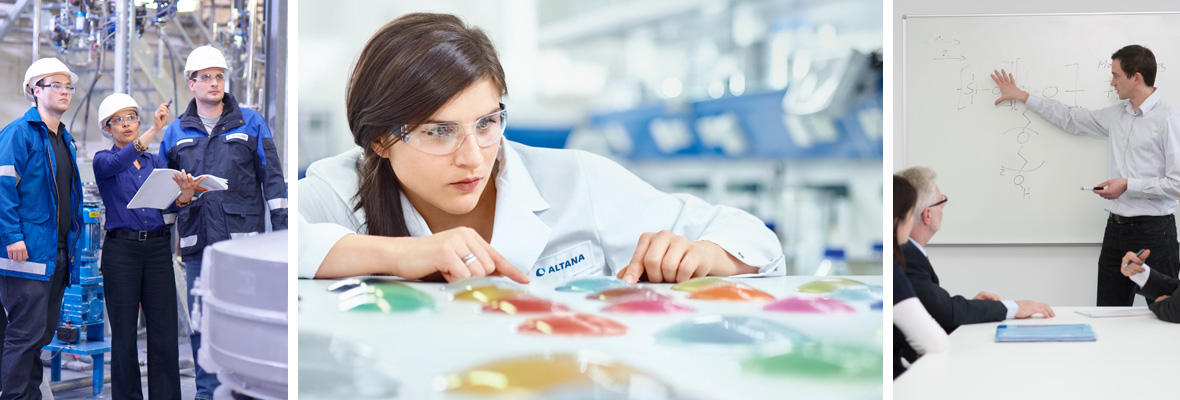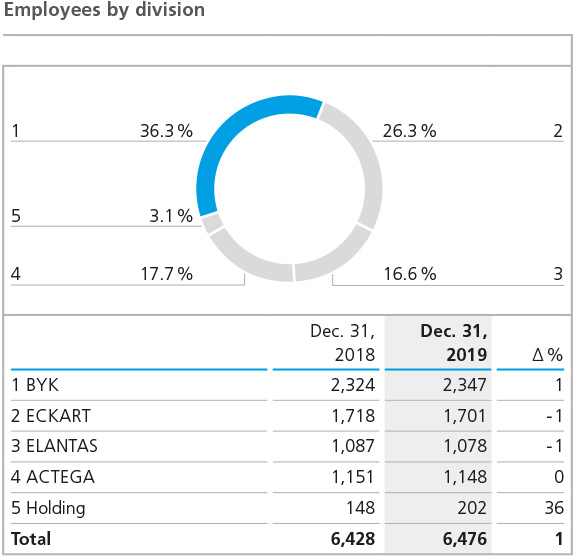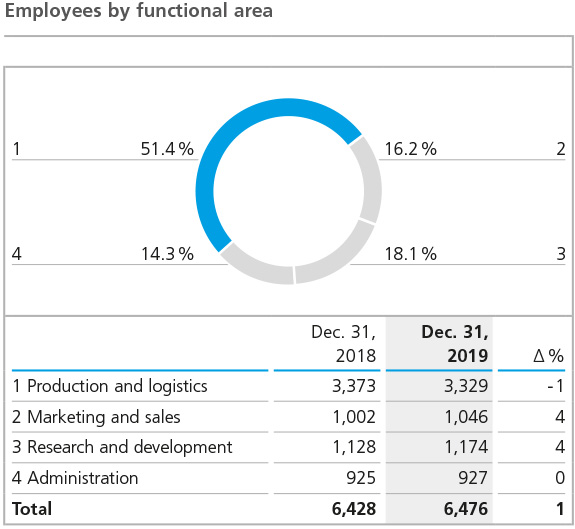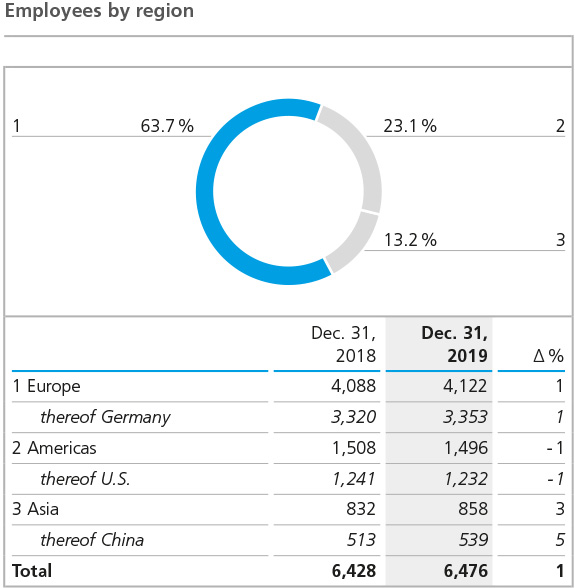Letter from the Management Board | About This Report | Sustainability Management | Corporate Governance | Corporate Bodies and Management | Report of the Supervisory Board | Creating Added Value at ALTANA | Group Management Report | Products | Safety and Health | Environment | Human Resources | Social Commitment | Consolidated Financial Statements (condensed version) | Multi-Year Overview | Global Compact: Communication on Progress (COP) | ALTANA worldwide | List of Full Ownership | Overview - About This Report | Contact
Innovation
As a specialty chemicals company, innovations are an important factor for ALTANA, enabling us to offer our customers new, competitive solutions and at the same time to meet cutting-edge requirements regarding performance profile, costs, environmental protection, and sustainability. Thanks to close cooperation with our customers we are integrated into new fields of development at an early stage and thus can develop customized solutions quickly and reliably. We build on existing competencies, on the one hand, and gain access to new ones on the other, in order to continuously adapt our product portfolio to market and customer needs. State-of-the-art analytics in chemical labs as well as application technology testing laboratories geared to specific features are available to our researchers and developers for targeted development.
In addition to the activities in the business divisions, selected innovations are initiated and coordinated at the ALTANA level, aimed at tapping new business fields and absorbing technology and market trends. This is achieved through different procedures, namely, through the ALTANA Institute, the central management of technology platforms, as well as corporate venturing investments.
With the help of the ALTANA Institute, external networks and close cooperation with universities and research institutes around the world are used to harness outside impetus. This year, the first projects were successfully completed after a three-year period and a technology transfer to the respective business areas began.
In the 2019 fiscal year, ALTANA again invested an aboveaverage amount in technology platforms and thus accelerated research activities that had been initiated in previous years. The Printed Electronics platform reached an important milestone. After years of intensive research and development, it was integrated into the organization of our ELANTAS business unit to be able to optimally utilize synergies in sales as well as market penetration. In 2019, ALTANA also made considerable progress in the field of 3D printing for additive production. ALTANA and the printer manufacturer dp polar, in which the company has had a stake since 2017, presented the world’s first 3D printing system with a continuously rotating print platform at the leading international trade fair for additive manufacturing Formnext. The printing inks specially developed by ALTANA for this purpose enable the components to be produced according to customer-specific requirements with high precision and productivity in areas such as the automotive, aerospace, and medical technology sectors. The laser transfer technology HELIOSONIC, which has also been set up as a technology platform, can open up further market segments in collaboration with dp polar in the medium term. In 2019, the HELIOSONIC platform succeeded in putting the first prototype into operation. As a result, the future direction of the system can be shaped in discussions with customers.
Thanks to the close cooperation between the central departments Corporate Innovation and Corporate Venturing, ALTANA can continuously examine technology and market potential and enter new attractive markets by means of targeted investments in transformative technology companies. In this context, ALTANA further intensified its investment in the Israeli industrial digital printing company Velox Ltd. in the 2019 fiscal year.
The basis for our innovative strength is an open and dynamic corporate culture that gives the 1,174 employees in our research and development centers around the world the freedom to act creatively and entrepreneurially. The equipment in our development centers enables our employees to implement their ideas in marketable solutions. In the year under review, expenses for research and development amounted to € 165.6 million, a significantly higher amount than in the previous year (€ 154.1 million). The further increase in research and development expenses to 7.4 % of sales (previous year: 6.7 %) is linked to the achievement of important milestones and the translation of individual customer requirements into future, innovative products.
Employees
At the end of 2019, the companies of the ALTANA Group employed 6,476 people worldwide (previous year: 6,428). The number remained very stable over the course of the year, with an increase of 48 people or 1 %. The slight rise of 1 % is primarily due to an acquisition in the BYK division (+ 27 employees).
In the BYK division, the workforce rose slightly by 23 to 2,347 (previous year: 2,324). The increase is due to the opposite effect. On the one hand, 38 employees were transferred to a Group holding company, where cross-divisional services have been increasingly bundled since 2018. This decline was offset by the newly acquired business activities of Paul N. Gardner in the USA (+ 27 employees), which were integrated into BYK’s testing and measuring instrument business in mid-2019. The number of employees also increased in the course of the year as a result of the strategic expansion of activities in the additive business in Shanghai and the testing and measuring instruments business in Germany.
By contrast, the staff numbers in the ECKART division decreased by 17 to 1,701 in the course of 2019 (previous year: 1,718). The lower headcount particularly affected the German sites in Hartenstein and Wackersdorf and the division’s U.S. sites. It is attributable to the challenging economic situation and the associated capacity utilization, as well as corresponding countermeasures, which limited staff recruitment to an absolute minimum in 2019.
ELANTAS recorded a slight decline of 9 employees to 1,078 (previous year: 1,087). But the development within the division was uneven. The workforce was increased only in manufacturing. Meanwhile, the number of employees in other areas decreased.
In the ACTEGA division, the number of employees remained virtually constant during the year at 1,148 (previous year: 1,151). While the headcount increased at the German sites in particular, the number of employees decreased at its sites in the U.S. and Brazil.
Staff numbers of the Group holding companies climbed by 54 to 202 in the past fiscal year (previous year: 148). This is mainly due to the expansion of the activities of the service company implemented in the previous year at the holding level (+ 38 employees). In 2019, the holding company took over the financial accounting and general administration functions for the Wesel site as well as an SAP Competence Center. The staff had previously been employed in the BYK division.
The functional structure of the workforce did not alter significantly in the 2019 fiscal year. With 51 %, or 3,329 people (previous year: 3,373), most of the employees continued to work in production, although this was the only area in which staff numbers declined in the course of the year due to lower capacity utilization. In contrast, the number of people working in research and development increased by 46 to 1,174 in 2019 (previous year: 1,128). The number of employees in marketing and sales also increased, by a total of 44, in the course of 2019. As in previous years, administrative functions continued to account for the smallest share of the Group-wide workforce, with 927 employees (previous year: 925). The number of employees in this area remained virtually unchanged over the course of the year.
In 2019, there were only minor shifts in the regional structure compared to the previous year. With 4,122 employees (previous year: 4,088), the European Group companies continued to employ by far the largest number of people. 3,353 (previous year: 3,320) were employed in Germany at the end of the year, the majority of them at ECKART’s and BYK’s largest production sites, in Hartenstein and Wesel, respectively. The number of employees in the Americas fell slightly by 12 from 1,508 in the previous year to 1,496 at the end of 2019 despite the acquisition of the business activities of Paul N. Gardner. By contrast, the number of employees in the Asian Group companies rose from 832 in the previous year to 858 in 2019, the largest percentage increase.
At the end of the 2019 fiscal year, 1,689 women and 4,787 men worked for ALTANA. On the balance sheet date, 90 % of all employees had an unlimited and 10 % a limited employment contract. This ratio was the same for both genders. At the end of 2019, 77 % of the female employees were working full-time and 23 % part-time. 97 % of the male employees worked full-time. Apart from its own employees, 150 people from employment agencies worked for the ALTANA Group on December 31, 2019.
ALTANA continues to compete internationally for specialists and managers. Like all companies in the chemical industry, in the years to come the ALTANA Group, particularly in Europe, will enter a phase that due to the demographic development has made precision succession planning indispensable. As a result, talent management and human-resource development play a key role in ALTANA’s agenda for the future (Keep Changing Agenda). The aims are to mobilize people at ALTANA, to increase diversity at all levels, to further develop leadership culture, and in doing so to strengthen entrepreneurial thinking and action. To achieve these goals, we examined and revised existing personnel tools in 2019. We focused on the revision of the so-called compass dialogue (annual talks with employees). The progress dialogue as part of the compass dialogue is to be supplemented in the future by an assessment of competence and potential as well as a development plan. Hence the competence model developed in the previous year was integrated even more strongly into the existing human-resource instruments. All of these innovations aim to optimize the basis for personnel decisions. Increased transparency and dialogues with the respective managers, which are even more strongly focused on employee development, will make employees even more loyal to the company. In this way, ALTANA is particularly concentrating on more effective succession planning.
The “HR Transformation” project launched in previous years, which serves to strategically reposition personnel, was continued in 2019. To be able to meet future challenges on the labor market in an increasingly digitalized world in the best possible way, in 2019 ALTANA took the first steps on a global level to redesign its master data and organizational structures in terms of processes and digitally. These initial changes form the basis for digitalizing all processes of our personnel organization in the coming years. In 2020, the next step is to digitally implement the process families Performance & Goals and Learning Management. In order to adequately take into account the operational and strategic needs of the divisions, ALTANA redefined the organizational interaction between local, regional, and divisional roles in the area of human resources. As a result, for example, divisional HR managers are appointed for the four divisions and regional HR managers are appointed across all divisions in regions with a high number of employees.
Declaration of Corporate Governance Pursuant to Section 289f (4) of the German Commercial Code (HGB)
Promoting women in management positions remained a focus in the 2019 fiscal year. By intensifying measures that had been introduced in the past, and with new instruments, we further anchored the expansion of diversity in our humanresource management. The ratio of women in ALTANA’s national and international management development programs has increased significantly in recent years. In addition, our further education program includes special offers for women. The mentoring program for women launched in 2016 was continued in 2019. In addition, ALTANA created various informal platforms in order to intensify dialog on this topic. Among them are regular meetings of women in management positions that focus on strengthening the network, and workshops for further development of familyfriendly employment models intended to contribute to continual improvement of the general working conditions at ALTANA.
ALTANA’s medium- to long-term goal is to increase the share of women in management positions to the percentage of women in the entire workforce.
In keeping with legal requirements regarding equal participation of women in management positions in private business and the public service sector, ALTANA AG’s Supervisory Board specified targets for the share of women in the company’s Management and Supervisory Boards. For the Supervisory Board, a target of 25 % was resolved by the end of the target-achievement period on June 30, 2020. For the Management Board, no personnel changes or an extension of the body are planned by the end of the targetachievement period, and so the body will continue to be without any woman. For the first management level under the Management Board, the Management Board resolved a share of women of 20 % and for the second management level a share of 30 %. Targets were also defined for the German companies subject to codetermination.





